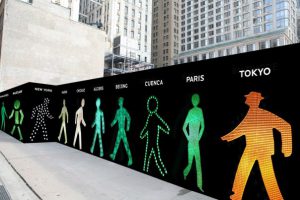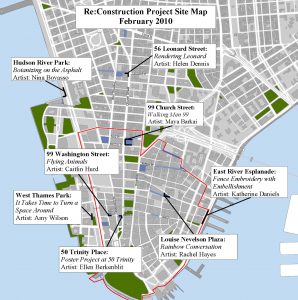
Walking through Lower Manhattan reminds me of three fateful courses I took in my sophomore year of college: Karsten Harries’ Philosophy of Architecture, Alex Garvin’s Study of the City, and Vincent Scully’s Intro to Art History. Thirty-one years later, these professors still guide my thinking.
I only wish I had done more of the reading!
Harries taught us what buildings and urban design say about people, what they want and how they live. Garvin, later the planning head for the Lower Manhattan Development Corporation, used New York City case studies to show how planning and design intersect with politics and real estate, to extraordinary or disastrous effect. And Scully took us on a 7,000-year world tour, connecting the dots between art, culture and history; his discussion of the Old Masters introduced the concept of pentimento, when an image—long since painted over—suddenly becomes visible in the picture that covered it.
Pentimento is certainly on display in Lower Manhattan, where 350-year old cobblestone lanes wind through a modern Financial District, 19th-century storefronts host the latest restaurants and skyscrapers built before there was a zoning resolution are filled with fully wired 21st century tenants. Now there’s a new form of historical overlay here: It is Re:Construction, our temporary public art program, funded by LMDC.
A novel construction mitigation program, Re:Construction’s projects are temporary by definition and design. They come and go with construction, eventually replaced by permanent buildings and infrastructure. And that’s as it should be. But, with all the rebuilding underway in Lower Manhattan, it should come as no surprise that there are eight current Re Con projects.
Re:Construction has provided an unexpected quick fix of beauty and whimsy at 15 construction sites since November 2007, and we plan to unveil at least as many more.
It is particularly exciting to discover a Re:Con project where you least expect it. But why not take a self-guided tour of the whole “gallery”, from Tribeca to the East River Esplanade?
56 Leonard Street. Helen Dennis’ Rendering Leonard uses photography and a black-white palette to evoke a haunting neighborhood streetscape.
Hudson River Park. Nina Bovasso’s signature flowers is Botanizing the Asphalt on 400 feet of concrete jersey barriers.
99 Church Street. Maya Barkai’s Walking Men 99 (above) highlights Lower Manhattan as a global center with 99 versions of the international “walk” symbol.
99 Washington Street. Inspired by bucolic landscapes, Caitlin Hurd’s Flying Animals contrasts the hectic city with the tranquility of rural life.
West Thames Park, Battery Park City. Amy Wilson’s storybook mural is aptly titled It Takes Time to Turn a Space Around.
50 Trinity Place. With Poster Project, Ellen Berkenblit presents a series of fanciful ink and graphite drawings on a vinyl banner.
East River Esplanade. Katherine Daniels uses ribbon-like stitches of plastic and painted spools and jar lids on 600 feet of Fence Embroidery with Embellishment.
Louise Nevelson Plaza. Rachel Hayes’ Rainbow Conversation turns wire fencing into a vibrant experience with stripes of opaque and sheer fabrics.

Stay tuned for more projects in 2010, and visit our Web site at https://downtownny.com/reconstruction.
—Liz Berger is President of the Downtown Alliance


